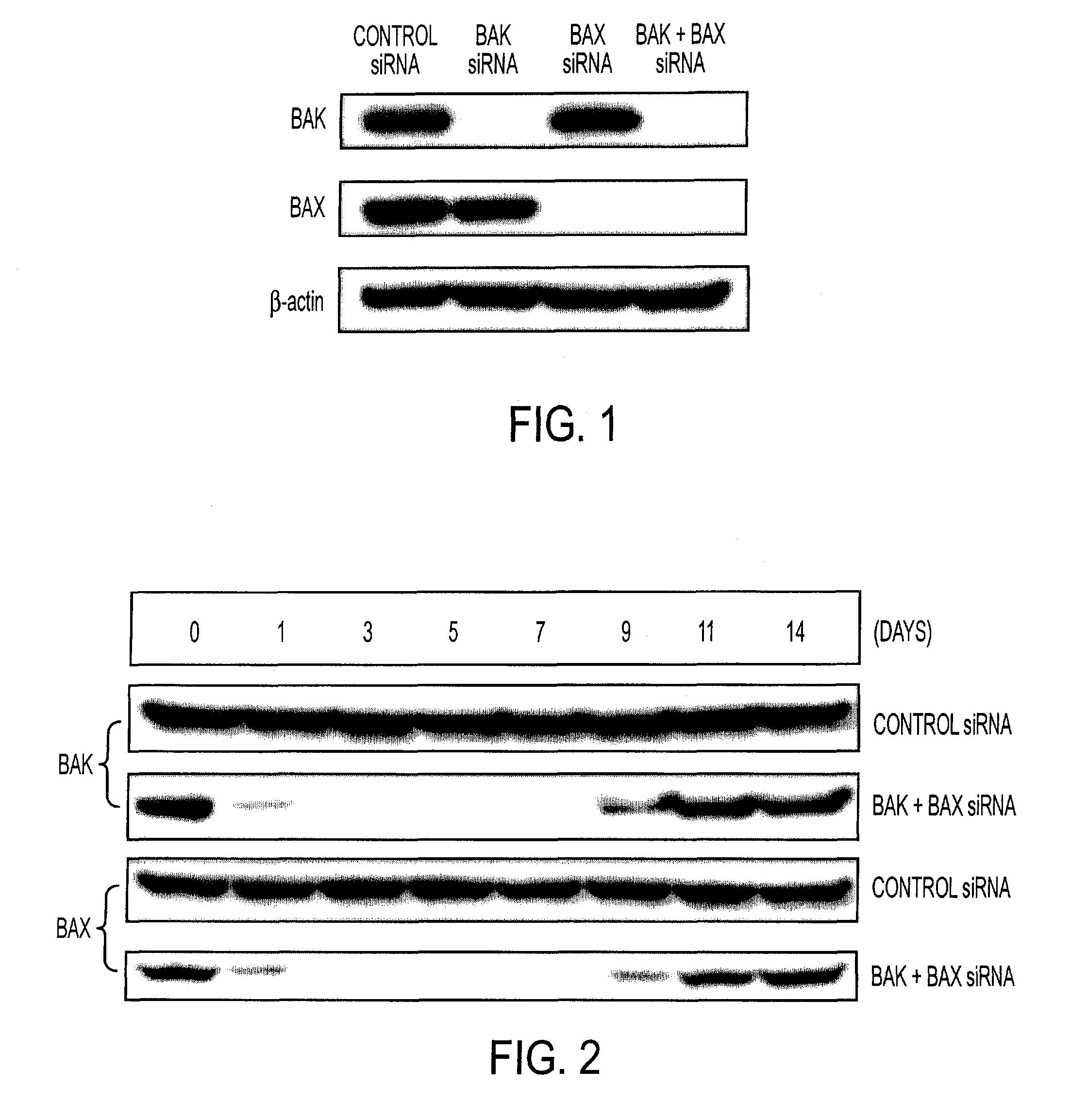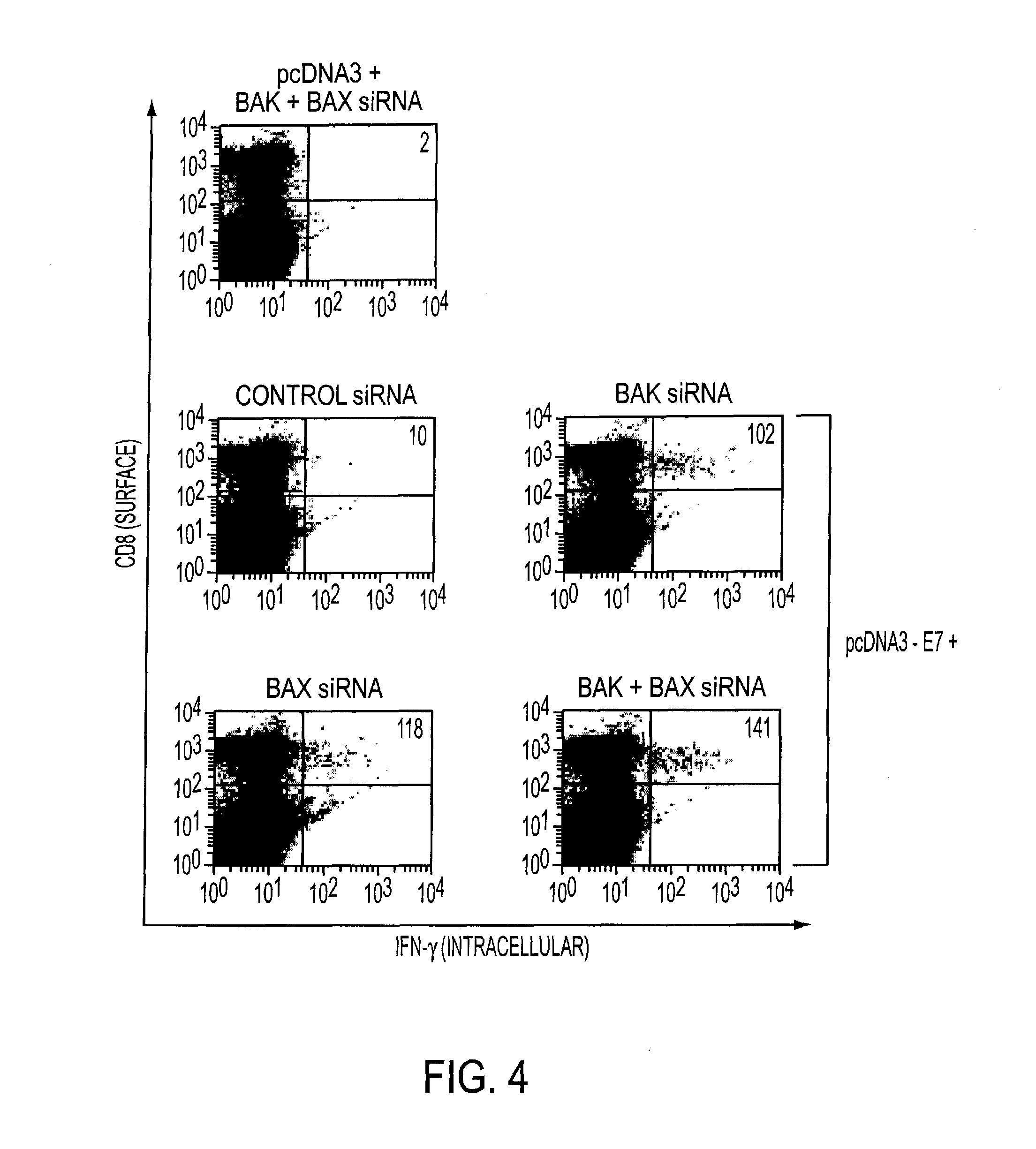RNA interference that blocks expression of pro-apoptotic proteins potentiates immunity induced by DNA and transfected dendritic cell vaccines
a technology of rna interference and dendritic cell vaccine, which is applied in the field of molecular biology, immunology and medicine, can solve the problems of limited life span of dendritic cells, lack of vaccine potency, and impede the long-term ability of antigen-specific t cells to prime antigens, so as to enhance vaccine potency, promote survival, and enhance the presentation of antigens
- Summary
- Abstract
- Description
- Claims
- Application Information
AI Technical Summary
Benefits of technology
Problems solved by technology
Method used
Image
Examples
example 1
Materials and Methods
Plasmid DNA Constructs and DNA Preparation:
[0315]The production of the following vectors have been described: pcDNA3-E7, pcDNA3-Sig / E7 / LAMP-1, pcDNA3-E7 / HSP70, pcDNA3-CRT / E7, pDNA3-E7 / GFP and pcDNA3-OVA (Kim T W et al., J Clin Invest 112: 109-117, 2003; Cheng W F et al., J Clin Invest 108: 669-678, 2001; Hung C F et al., Cancer Res 61: 3698-3703, 2001; Chen C H et al., Cancer Res 60: 1035-1042, 2000; see also U.S. Pat. No. 6,734,173 and published patent applications WO05 / 081716, WO05 / 047501, WO03 / 085085, WO02 / 12281C2, WO02 / 074920, WO02 / 061113, WO02 / 09645, and WO01 / 29233. The plasmid containing a sequence encoding influenza hemagglutinin (HA), pcDNA3-HA, was provided by Dr. Drew Pardoll, Johns Hopkins School of Medicine. The accuracy of these constructs was confirmed by DNA sequencing. DNA was amplified in E. coli DH5α and purified as described in Chen, C H et al., supra).
Preparation (Synthesis) of siRNAs and Transfection:
[0316]siRNAs were synthesized using 2′-O-...
example 2
Transfection with Bak and / or Bax siRNA Leads to Downregulation of Bak and Bax, and Resistance to Apoptotic Cell Death
[0341]To determine if the expression of Bak and / or Bax was downregulated in a DC cell line (DC-1) transfected with Bak and / or Bax siRNA, western blot analysis was performed using cell lysate from DC-1 cells, transfected with the various siRNAs. As shown in FIG. 1, the expression of Bak and / or Bax proteins was undetectable in DC-1 cells transfected with Bak and / or Bax siRNA. In contrast, expression of Bak and Bax proteins was detected in DC-1 cells after transfection with control siRNA, the levels of expression being similar to the levels in nontransfected DC-1 cells. The expression of β-actin protein was consistent among all DC-1 cell groups. The kinetics of inhibition of Bak and Bax protein expression by DC-1 cells transfected with Bak+Bax siRNA were examined. As shown in FIG. 2, significant downregulation of Bax and Bak expression was observed 1 day after transfecti...
example 3
Coadministration of Bax+Bak siRNA with Antigen-Specific DNA Vaccines Significantly Enhances Numbers of Antigen-Specific CD8+ T Cell Precursors in Vaccinated Mice
[0344]To determine if the anti-apoptotic action of Bak+Bax siRNA observed in DCs in vitro can be manifest in vivo, Bak+Bax siRNA was coadministered with pcDNA3-E7 intradermally via gene gun. As shown in FIGS. 4 and 5, coadministration of pcDNA3-E7 with Bak and / or Bax siRNA significantly enhanced the E7-specific CD8+ T cell response (by at least 10-fold) in vaccinated mice, compared to coadministration of pcDNA3-E7 with control siRNA.
[0345]To determine if this result was obtained using other antigens, pcDNA3-HA and pcDNA3-OVA plasmids were coadministered with Bak+Bax siRNA. As shown in FIGS. 6-7, the coadministration of pcDNA3-HA or pcDNA3-OVA with Bak+Bax siRNA significantly enhanced the HA- and OVA-specific CD8+ T cell response in vaccinated mice, compared to coadministration of the antigen vectors with control siRNA. Thus ...
PUM
| Property | Measurement | Unit |
|---|---|---|
| body weight | aaaaa | aaaaa |
| density | aaaaa | aaaaa |
| volume | aaaaa | aaaaa |
Abstract
Description
Claims
Application Information
 Login to View More
Login to View More - R&D
- Intellectual Property
- Life Sciences
- Materials
- Tech Scout
- Unparalleled Data Quality
- Higher Quality Content
- 60% Fewer Hallucinations
Browse by: Latest US Patents, China's latest patents, Technical Efficacy Thesaurus, Application Domain, Technology Topic, Popular Technical Reports.
© 2025 PatSnap. All rights reserved.Legal|Privacy policy|Modern Slavery Act Transparency Statement|Sitemap|About US| Contact US: help@patsnap.com



